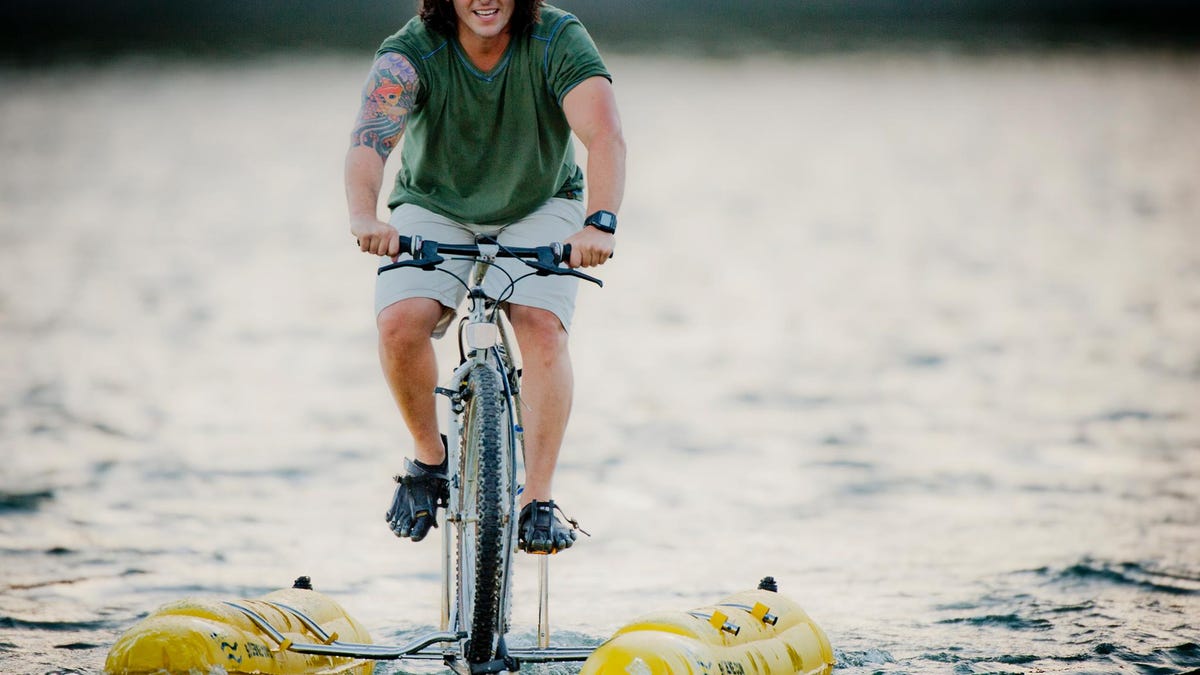Cyclist bikes across SF Bay, no bridge required
Next up in his quest to turn "aquatic biking" into a global phenomenon, BayCycle Project founder Judah Schiller will cross the Hudson on a bike fixed to a portable flotation device.

Divine intervention might be needed before you can walk on water, but biking on water will become a recognized international sport if Judah Schiller has his way.
Schiller is the brain (and the legs) behind the BayCycle Project, an initiative to turn water biking from a little-known cycling caper into a common recreational pastime and alternative form of transportation.
"BayCycle Project is about opening the oceans, bays, rivers, and lakes that cover two-thirds of our planet to people who love to bike," Schiller said. "The ride doesn't end at the water's edge."
If you've never heard of water biking, you can be forgiven for noting that H2O makes for a, well, less-than-solid biking surface. The bikes do get a little help, of course -- from a pedal-powered portable flotation system. The whole setup weighs about 20 pounds and fits in a backpack, which comes with two inflatable pontoons, plus clamps, rods, and a gearbox to capture the energy of a spinning rear wheel and transfer it to a propeller attached to a till under the front wheel.
To prove that biking on water actually floats, Schiller, a San Francisco Bay Area resident, rode across the San Francisco Bay from Oakland to the city last week. On Thursday, he'll attempt the same feat on the Hudson River, departing at 11 a.m. ET from the Pier 13 Boat Club in Hoboken, N.J., and, hopefully hitting New York River Sports in Manhattan an estimated half hour to 45 minutes later.
"I'm not in a rush," he told CNET. "Can't wait to have the view of Manhattan from a bike on the water."
While a handful of "aquatic bikes" already exist, the difference between those and the system Schiller is pedaling comes down to weight and bike.
Many of the other systems "are really pedal boats on steroids and weigh hundreds of pounds or have pedals and handlebars, but not exactly a bike in any true sense of it," Schiller explained. "Nothing you'd travel with or put on a car bike rack."
The BayCycle Project, on the other hand, is currently doing an Indiegogo run in hopes of raising $50,000 to purchase flotation kits, made by Italian company Shuttle Bike, that let riders use their own bikes to ride on water. (Schiller, a bike lover but not a professional cyclist, crossed the bay on his Bianchi.)
The kits would, among other things, help the BayCycle Project host free and sponsored group rides in the SF Bay Area, as well as five additional US cities, to get momentum flowing for aquatic biking. As of this writing, the crowdfunding campaign has raised a little over $3,300 toward its goal.
Road map for the biking life aquatic
In five years, Schiller would like to see a thriving global community of water bikers, with major water biking events and competitions around the world and virtual bike lanes installed in navigable waterways near several urban centers. The lanes, he suggests, could be projected onto the water, or involve data -- weather, currents, ship finders, and real-time ride times for other water cyclists -- that could be accessed via app.
In 10 years, he pictures an Olympic sport, and a mature industry that caters to the various needs, abilities, and preferences of riders.
"The trajectory for this to me seems no different than what happened with mountain biking, which started in the late 1960s where guys took Schwinns and started barreling down the slopes of Mt Tam," said Schiller, who once practiced law and now serves as CEO of design and innovation firm AIKO Agency. "Sales of mountain bikes surpassed that of road bikes 10 years later."
Schiller first conceived of pedaling across the bay to tout water biking while on a boat underneath the new eastern span of the Bay Bridge. The western span doesn't have a bike lane to take residents of the East Bay into San Francisco, and Schiller estimates that it will take another $500 million and at least a decade to retrofit the western span with such a passageway.
He'd rather not wait that long for cyclists to get across water without bridges or bike lanes, an ambition that the San Francisco Bike Coalition supports.
"We applaud Judah's innovation in finding a way to bike across the Bay -- in lieu of a full Bay Bridge bike path," said Kristin Smith, communications director for the organization, which advocates for biker safety and promotes bikes for everyday transportation. "As the San Francisco Bicycle Coalition focuses on street safety, we can't speak to the safety of aquatic biking. While Judah works on a safe bikeway on the water, we will continue our work to get a bike path above it."
Schiller notes that each pontoon contains sturdy double chambers, so there's backup if one gets punctured.
"In the future, I can see systems that are actually made of harder materials that do not require inflation at all," he said.
As Schiller prepares for his Hudson River journey, he uses the word "epic" to describe his SF Bay crossing of about 3.5 miles, which lasted approximately 45 minutes.
"[I was] really stoked to be out on the SF Bay alone on a bike, feeling the movement of the water, having a gorgeous panoramic view of San Francisco, Alcatraz, and out to the Golden Gate," he said. "Very special to be the first person to ever bike under the Bay Bridge."

